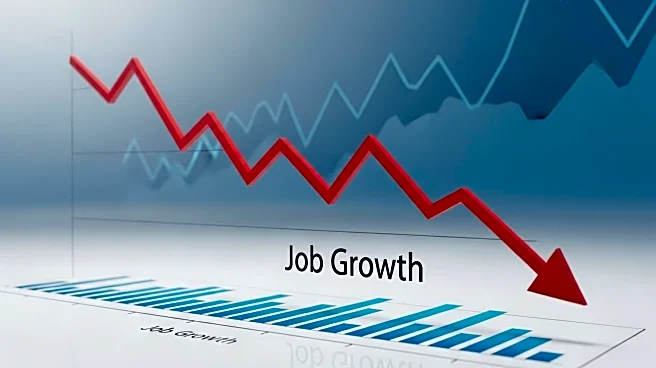What's Happening?
The U.S. economy continues to demonstrate resilient growth, with a market-implied forward growth rate of approximately 1.6%, as reported by Goldman Sachs. Despite this growth, the job market is showing signs of weakness, with average monthly job gains of only 40,000 from April 2024 to August 2025. This slowdown in job creation has sparked discussions about potential Federal Reserve interest rate cuts. Inflation has risen in line with expectations, maintaining hopes for rate cuts. The unemployment rate stands at 4.3%, which is lower than the historical average, yet the economy is creating fewer jobs each month. Recent revisions to job numbers have shown a significant slowdown, with some months even experiencing negative job growth.
Why It's Important?
The current economic situation highlights a complex landscape where growth is strong, but the labor market is faltering. This scenario could influence Federal Reserve policy, potentially leading to interest rate cuts to stimulate job creation. The resilience of the U.S. economy, despite job market challenges, underscores the importance of consumer spending, particularly by wealthier consumers, in sustaining economic growth. However, the reliance on a narrow segment of consumers raises concerns about the economy's vulnerability to shifts in spending patterns. The situation also reflects broader economic trends, such as the impact of immigration policies on labor supply and the challenges of accurately measuring job market health.
What's Next?
The Federal Reserve may consider interest rate cuts to address the slowing job market and support economic growth. Policymakers will need to balance the risks of inflation with the need to stimulate job creation. The ongoing revisions to job data suggest that initial reports may not fully capture the labor market's health, necessitating careful analysis of subsequent data. Additionally, the potential for changes in consumer spending patterns could impact economic stability, making it crucial for policymakers to monitor these trends closely.
Beyond the Headlines
The current economic dynamics highlight the challenges of maintaining a balanced economy where growth is not overly reliant on a specific consumer segment. The situation also raises questions about the effectiveness of current labor market data collection methods and the need for improved statistical models. Furthermore, the potential for interest rate cuts underscores the delicate balance policymakers must strike between fostering growth and controlling inflation.











